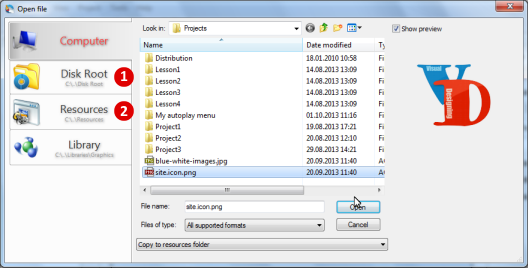User Guide > Working with projects and projects files
A project in Autoplay Menu Designer is a special container for all files required to build the executable, all resources and data. Technically, all files related to a project are stored in one folder created automatically every time you create a new project. Such approach helps managing projects and files most efficiently.
By default, the project folder is created in Computer/My Documents/Autoplay Menu Designer/Projects/<ProjectName>, where <ProjectName> is the name of the project. The path to the project folder can be changed in the New Project wizard. (more info Create a new project)
The project folder contains the following elements:
1. The project file. Typically it is named as <ProjectName>.amproject5
This file contains all information about your project including window positions, pages, elements, various system information, objects and properties and other important data.
2. The Disk Root folder. This folder contains files that will be placed to the root folder of a CD/DVD disk or a USB drive. Any file you use in a project is automatically copied to the Disk Root\Data folder unless the folder already contains it. You can also copy all necessary files to the Disk Root or Disk Root\Data folder manually using Windows Explorer.
The name of the Data folder can be changed in the Project | Settings | General menu.
3. The Resources folder. This folder contains such files as background images, buttons, object textures, sounds, shape images and other elements required to build the interface of the application. As soon as you use any file from outside of the project folder as an element of the interface, it is automatically copied to the project Resources folder.
![]() Important note: files in the Resources folder are compiled into the executable and won’t be visible after publishing of the ready application.
Important note: files in the Resources folder are compiled into the executable and won’t be visible after publishing of the ready application.
![]() Note that Autoplay Menu Designer offers a quick way to switch to the project folder, Disk Root and Resources folders using additional tabs in the file selection window
Note that Autoplay Menu Designer offers a quick way to switch to the project folder, Disk Root and Resources folders using additional tabs in the file selection window ![]() ,
, ![]() :
:

The final output product produced upon building a project depends on the project building mode. There are few of them:
1. Build an auto-play menu application
This mode produces a standard Windows application executable (.exe). It is also the most flexible mode. This app type is recommended for projects containing large files like video presentations, movies, documents, setup programs and so on).
The build result is placed to <ProjectFolder>\Disk Root\ . This folder contains the following files:
| • | autorun.inf - the file required for the autorun to work; |
| • | <AppName.exe> - application executable, where AppName is specified in the Project | Settings | Rebranding menu; |
| • | Other files that should be burned to the disk root. |
2. Build a standalone application
Selecting this mode produces a single standalone “all-in-one” Windows executable (.exe). All data files and files in the root folder are compressed into a single executable. We recommend this option for relatively small projects, because since all files of the project are compressed into one, additional time is needed to decompress them upon run, which may be inconvenient in case of large files.
The build result is placed to <ProjectFolder>\Executable. The folder contains the following files:
| • | autorun.inf - the file required for the autorun to work; |
| • | <AppName.exe> - application executable, where AppName is specified in the Project | Settings | Rebranding menu. |
3. Build a Web application
Use this mode to build a Web/HTML5 application and supporting files including an HTML start page that loads your application in a browser. This option is recommended for cross-platform solutions as well as for publishing on Web for further distribution via a link.
The Web application mode has certain limitations, and some functions are not supported for it. For more information, see Web application limitations.
The build result is placed to <ProjectFolder>\Html Application. The folder contains the following files:
| • | index.html - A web page and JavaScript that loads the Web/HTML5 application into a browser. |
| • | Images folder - the folder contains additional thumbnails. |
| • | Scripts folder - the folder contains application scripts. |
| • | Disk Root folder – a copy of the <ProjectFolder>\Disk Root folder |
| • | Resources folder – a copy of the <ProjectFolder>\Resources folder |